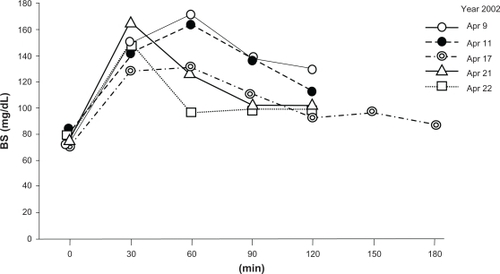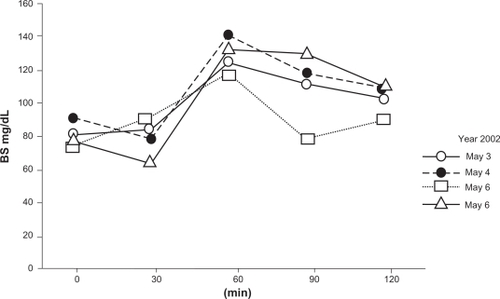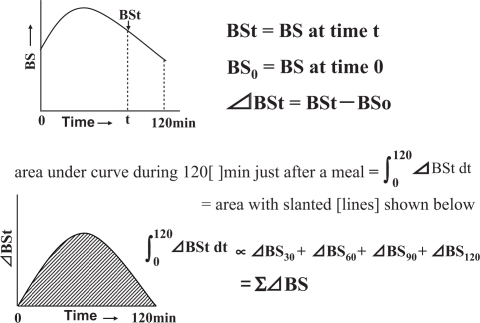 ?Mathematical formulae have been encoded as MathML and are displayed in this HTML version using MathJax in order to improve their display. Uncheck the box to turn MathJax off. This feature requires Javascript. Click on a formula to zoom.
?Mathematical formulae have been encoded as MathML and are displayed in this HTML version using MathJax in order to improve their display. Uncheck the box to turn MathJax off. This feature requires Javascript. Click on a formula to zoom.Abstract
There is a belief that walking just after a meal causes fatigue, stomach ache, and other types of discomfort. However, the author and one volunteer participant had no such negative reactions, and found that walking just after a meal was more effective for weight loss than waiting one hour after eating before walking. For people who do not experience abdominal pain, fatigue, or other discomfort when walking just after a meal, walking at a brisk speed for 30 minutes as soon as possible just after lunch and dinner leads to more weight loss than does walking for 30 minutes beginning one hour after a meal has been consumed. The author lost nearly 3 kg and a volunteer participant lost nearly 1.5 kg during one month of walking just after lunch and dinner. The author walked at a brisk pace, while the volunteer walked at a stroll. We repeated the preliminary experiment twice, between April and early May 2002, and once between August and September 2006, and obtained the same results.
Introduction
Repeated hyperglycemia after meals causes hyperinsulinemia and a resultant resistance to insulin, which is problematic for people who have mild diabetes mellitus or are at risk for diabetes mellitus, and for people with obesity, because insulin is the obesity hormone.Citation1 Suppressing hyperglycemia after a meal will suppress insulin hypersecretion, helping to suppress the storage of internal fat and thus preventing obesity from worsening.Citation2 People often walk to decrease their weight or to maintain a healthy weight. However, walking is not necessarily effective. Based on the fact that the blood sugar (BS) increase after a meal causes an increase in the blood insulin level, it was hypothesized that walking after a meal would prevent the BS level from increasing, because walking consumes BS. Changes in BS levels without walking after a meal and with walking at various times after a meal have previously been reported.Citation3 BS is at its highest 30–60 minutes after a meal and reaches its lowest 2–3 hours after a meal in normal people (). This schedule was confirmed in our trials. Accordingly, if walking is started as soon as possible after a meal, the increase in BS level will be limited by BS consumption during walking, and the insulin increase that occurs in response to a meal load will be restricted as well.
Figure 1 Change of BS after a meal without walking (BS at 0 min means the BS just before the meal. BS at 30 min means the BS at 30 min after starting walking. BS at other times mean the same as at 30 min).

The author lost nearly 3 kg by fast walking after lunch and dinner for a one-month period, and the volunteer participant lost nearly 1.5 kg by walking at a slow pace for the same one-month period. The experiment was performed once between April and early May 2002, and between August and September 2006, after consuming lunches and dinners consisting of Japanese food, 500 ± 50 calories at a time, and without performing any other exercises or consuming alcohol during this trial period. We did not change our intake of routine medications after this test began. The details are discussed below.
Methods
One 60-year-old Japanese female (the author) with a family history of diabetes mellitus and one 67-year-old Japanese female volunteer participated in this experiment. The subject characteristics are shown in . We measured the BS level with the pocket-size BS analyzer, Glucocard Diameter, (ARKRAY Inc, Kyoto City, Japan), and the glucose kit, Diasensor (ARKRAY Inc). The coefficient of variation of the BS measurement was about 2.3%. We took 2–5 measurements each time and determined the average (if discrepancies were relatively big, these were repeated 3–5 times and the mean value adopted using test papers excluding abnormal data).
Table 1 The background of subjects of this trial
We measured the BS level just before a meal and at 30, 60, 90, and 120 minutes after a meal was consumed without walking () and with walking for 30 minutes just after a meal (). As shown in , we assumed the BS level at time (t) was BSt, and ΔBSt = BSt – BS0, which means ΔBS0 = 0. The total increase in BS over 120 minutes by meal loading will correlate to the area under the curve of ΔBSt – t for 120 minutes just after a meal
. We assumed that
The volunteer measured her BS levels in the same way, and her results showed the same tendency (data not shown).
To confirm that walking controlled the glucose increase, ΣΔBS without walking after a meal (ΣBS(−)) and the ΣΔBS with walking for 30 minutes just after a meal (ΣBS(0)) was compared, as shown in .
Table 2 Comparison of BS increase after meal with or without walking
Finally, to ensure that walking for 30 minutes just after meals (lunch and dinner), is more successful for weight loss than walking beginning 60 minutes after a meal, the ΣΔBS(0) and ΣΔBS(60), beginning 60 minutes after a meal, was compared. To make an accurate comparison, the author walked just after a meal on one day and started to walk 60 minutes after a meal on the next day ().
Table 3 Comparison of ΣΔBS walking for 30 minutes just after meal ΣΔBS(0) and wakling for 30 minutes from 60 minutes after meal ΣΔBS(60)
Results and discussion
In , the backgrounds of the two subjects are described. The main difference between the first and second trials is that the subjects consumed unpolished rice in the first trial but consumed polished rice in the second trial. As shown in , the BS level on the curve for April 17, 2002, was similar at 120 and 180 minutes, which implied that the BS reached its lowest level at 120 minutes after the meal load. This tendency was confirmed three times (data not shown). Because the insulin increase by meal loading during 120 minutes is supposed to correlate with the
the smaller the value of ΣΔBS (see ), the better it is for weight loss based on lower insulin production.
shows that the ΔBS(−) without walking after a meal was 219.5 ± 51 mg/dL (mean ± standard deviation). From here on, units are omitted, and ΔBS(0) = 79.5 ± 20.7 (P < 0.00001). This means that if we do not exercise just after a meal, then the glucose increase after the meal is about 275% of the glucose increase with walking just after a meal. This implies that the glucose increase with walking just after a meal will be 36% (79.5/219.5) of the case of not walking.
As shown in , the ΣΔBS of walking for 30 minutes just after a meal (ΣΔBS(0)) and walking beginning 60 minutes after a meal (ΣΔBS(60)) was compared. The ΣΔBS(0) was 153.8 ± 9.4 mg/dL and the ΣΔBS(60) was 185.8 ± 10.4 (P < 0.001). Although the numbers are small, it may be supposed that the glucose increase that occurs as a result of a meal load with walking just after a meal is markedly lower than that with walking that begins 60 minutes after a meal.
We tried 30–60 minutes of walking, beginning 60 minutes after a meal, or between meals, but this had no effect on body weight. It is widely believed that walking just after a meal is bad for health, and this may be true for many people, but for some people this activity may not be detrimental to health.
It is quite clear that walking suppresses the glucose increase after a meal (). Because glucose increases to its maximum at 30–60 minutes after a meal, walking must be started before the glucose level reaches a maximum, because once insulin is secreted it will play a role as an obesity hormone. It can be assumed that starting walking as soon as possible seems to be optimal to control BS levels.
People are taught to rest just after meals, and begin walking after 30–60 minutes have elapsed. This may be good advice for people who do not feel well when they start walking just after a meal, but for some people there is no need to rest after a meal because no such adverse reactions are felt. Some of the author’s patients who have followed this advice have achieved successful weight loss (data not shown).
The experiment described here was performed twice, once between spring and early summer in 2002 and once again between summer and early autumn in 2006, and weight loss was achieved during both trials. A ΣΔBS(0) of 79.5 ± 20.7 was achieved in 2002 and 153.8 ± 9.4 in 2006. This discrepancy may result from the fact that unpolished rice was consumed in 2002 and polished rice in 2006. Unpolished rice contains a lot of dietary fiber. In Japan, many people consume unpolished rice to decrease body weight and fat. However, even in 2006, we were able to lose weight, probably assisted by walking.
Although in this experiment, the author was able to reduce weight successfully many more studies would be required to clarify how to decrease weight or maintain optimal weight for a healthy state, because this experiment included only two subjects and was only carried out twice.
Disclosure
The authors declare no conflict of interest in this work.
References
- MoweryNTMayAKCollierBCGlucose metabolism, not obesity, predicts mortality in critically ill surgical patientAm Surg201076121377138321265352
- KasperDLBrawnwaldEFauciASHauserSLLongoDJamesonJLHarrison’s Principles of Internal Medicine16th edNew York, NYMcGraw-Hill2005
- ColbergSRZarrabiLBenningtonLNakaveAThomas SommaCSechristSRPostprandial walking is better for lowering the glycemic effect of dinner than pre-dinner exercise in type 2 diabetic individualsJ Am Med Dir Assoc200910639439719560716

